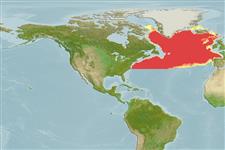Environment: milieu / climate zone / depth range / distribution range
Ecología
marino batipelágico; rango de profundidad 216 - 3237 m (Ref. 58018). Deep-water; 70°N - 35°N, 75°W - 2°W
Eastern Atlantic: Iceland, Faeroes and Shetlands to Portugal. Probably antitropical and present in other oceans. Northwest Atlantic: Canada (Ref. 5951).
Tamaño / Peso / Age
Maturity: Lm ? range ? - ? cm
Max length : 20.0 cm TL macho / no sexado; (Ref. 123983)
Radios blandos dorsales (total): 9-11; Radios blandos anales: 16 - 19. Body robust and compressed. Small gill opening. Anal fin base longer than the length of the caudal peduncle. Dark pigment on the scale pockets (Ref. 37473).
Bathypelagic (Ref. 58426). Sometimes caught in large aggregations. Eggs and larvae are pelagic (Ref. 6345). Feeds on small crustaceans (Ref. 5951). Minimum depth reported taken from Ref. 117245.
Life cycle and mating behavior
Madurez | Reproducción | Puesta | Huevos | Fecundidad | Larva
Cohen, D.M., 1984. Bathylagidae. p. 392-394. In P.J.P. Whitehead, M.-L. Bauchot, J.-C. Hureau, J. Nielsen and E. Tortonese (eds.) Fishes of the north-eastern Atlantic and the Mediterranean, Volume 1. Unesco, Paris. (Ref. 6345)
IUCN Red List Status (Ref. 130435)
Threat to humans
Harmless
Human uses
Más información
ReferenciasAcuiculturaPerfil de acuiculturaRazasGenéticaElectrophoresesheritabilidadEnfermedadesProcesamientoNutrientsMass conversion
ColaboradoresImágenesStamps, Coins Misc.SonidosCiguateraVelocidadTipo de nataciónSuperficie branquialOtolitosCerebrosVisión
Herramientas
Special reports
Download XML
Fuentes de Internet
Estimates based on models
Preferred temperature (Ref.
123201): 3.3 - 5.8, mean 3.9 °C (based on 372 cells).
Phylogenetic diversity index (Ref.
82804): PD
50 = 0.5078 [Uniqueness, from 0.5 = low to 2.0 = high].
Bayesian length-weight: a=0.00513 (0.00205 - 0.01282), b=3.00 (2.79 - 3.21), in cm total length, based on LWR estimates for this (Sub)family-body shape (Ref.
93245).
Nivel trófico (Ref.
69278): 3.3 ±0.38 se; based on food items.
Resiliencia (Ref.
120179): Medio, población duplicada en un tiempo mínimo de 1.4-4.4 años (Preliminary K or Fecundity.).
Fishing Vulnerability (Ref.
59153): Low vulnerability (10 of 100).
